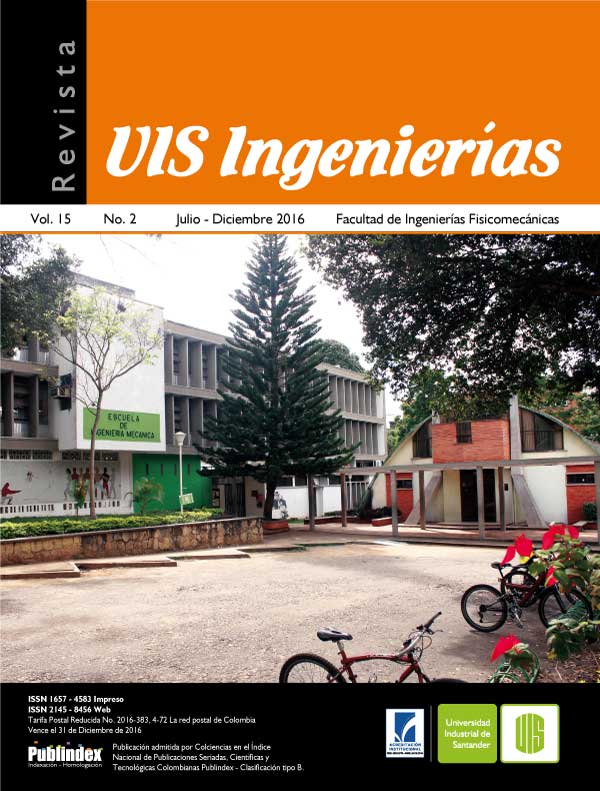Publicado 2016-06-28
Palabras clave
- Ingeniería Mecánica,
- análisis de elementos finitos,
- criterios de falla,
- ASTM D2290,
- tubería material compuesto
Cómo citar
Resumen
En este trabajo se investiga la caracterización del comportamiento mecánico de la tubería compuesta Fiberspar por medio de análisis por elementos finitos, con el fin de estudiar la integridad estructural de tuberías compuestas para el transporte de petróleo en Colombia. Se realizaron ensayos de laboratorio de acuerdo con la norma ASTM D2290 con el objetivo de determinar la resistencia a la tensión y comparar los resultados con el modelo numérico. Se utilizaron los criterios de fallo de Tsai-Wu y Tsai-Hill para la tubería trabajando a diferentes presiones, incluyendo la presión operacional, determinando valores para el fallo e identificando las capas críticas.
Descargas
Referencias
- R. Rafiee, “On the mechanical performance of glass-fibre-reinforced thermosetting-resin pipes : A review,” Compos. Struct., vol. 143, pp. 151–164, 2016.
- N. Ji, H. Geun, and J. Heum, “Structural analysis and optimum design of GRP pipes based on properties of materials,” Constr. Build. Mater., vol. 38, pp. 316–326, 2013.
- D. Hull, “Research on composite materials at Liverpool University. I. Failure of filament wound tubes,” Phys. Technol., vol. 13, no. 5, 1982.
- J. R. M. de Sousa, G. B. Ellwanger, and E. C. P. Lima, “Modelo tridimensional de elementos finitos para el análisis de esfuerzos de tubos flexibles,” Boletín Técnico, vol. 42, no. 2, pp. 1–20.
- X. Anping, S. Peng, Z. Jingjing, and Q. Yunxia, “FEA-based Comparison of Two Kinds of Steel Wire Reinforced Composite Pipes,” 4th Int. Conf. Intell. Networks Intell. Syst., pp. 184–187, 2011.
- K. Yu, E. V. Morozov, M. A. Ashraf, and K. Shankar, “Analysis of flexural behaviour of reinforced thermoplastic pipes considering material nonlinearity,” Compos. Struct., vol. 119, pp. 385–393, 2014.
- K. Yu, E. V. Morozov, M. a. Ashraf, and K. Shankar, “Numerical analysis of the mechanical behaviour of reinforced thermoplastic pipes under combined external pressure and bending,” Compos. Struct., vol. 131, pp. 453–461, 2015.
- L. A. Quintero Ortiz, J. R. Arciniegas Villamizar, M. C. Jiménez Romero, and A. Y. Vallen Vargas, “Efecto en las propiedades mecánicas de daños superficiales generados en tubería compuesta flexible para transporte de hidrocarburos.,” Rev. Ing., no. 42, pp. 39–48, 2015.
- Y. Bai, J. Tang, W. Xu, Y. Cao, and R. Wang, “Collapse of reinforced thermoplastic pipe (RTP) under combined external pressure and bending moment,” Ocean Eng., vol. 94, pp. 10–18, 2015.
- Y. Reutov, “The Calculation of Multilayer Polymer Pipes Using Finite Elements and their Application to Gas and Oil Pipelines,” pp. 3–5, 2013.
- J. L. C. G. De Kanter and J. Leijten, “Thermoplastic Composite Pipe : Analysis and Testing of a Novel Pipe System for Oil & Gas.”
- H. Bakaiyan, H. Hosseini, and E. Ameri, “Analysis of multi-layered filament-wound composite pipes under combined internal pressure and thermomechanical loading with thermal variations,” Compos. Struct., vol. 88, no. 4, pp. 532–541, 2009.
- M. Xia, “Bending behavior of filament-wound fiber-reinforced sandwich pipes,” vol. 56, pp. 201–210, 2002.
- P. D. Soden, M. J. Hinton, and A. S. Kaddour, “Biaxial test results for strength and deformation of a range of E-glass and carbon fibre reinforced composite laminates. Failure exercise benchmark data,” Fail. Criteria Fibre-Reinforced-Polymer Compos., vol. 62, pp. 52–96, 2004.
- P. A. Quigley, S. C. Nolet, and J. G. Williams, “Composite spoolable tube,” 2001.
- C. Kaynak, E. S. Erdiller, L. Parnas, and F. Senel, “Use of split-disk tests for the process parameters of filament wound epoxy composite tubes,” Polym. Test., vol. 24, no. 5, pp. 648–655, 2005.
- M. Carroll, F. Ellyin, D. Kujawski, and A. S. Chiu, “The rate-dependent behaviour of ± 55 ° filament-wound glass-fibre/epoxy tubes under biaxial loading,” Compos. Sci. Technol., vol. 55, no. 95, pp. 391–403, 1995.
- A. Majid and M. S. Bin, “Behaviour of composite pipes under multi-axial stress,” Newcastle University, 2011.
- E. J. Barbero, Finite Element Analysis of Composite Materials Using ANSYS, Second. Boca Raton, U.S.A.: CRC Press, 2013.
- L. Arias Maya and L. Vanegas Useche, “Falla de los materiales compuestos laminados,” Sci. Tech., no. 25, pp. 113–118, 2004.
- M. E. Tuttle, Structural Analysis of Polymeric Composite Materials. New York, U.S.A., 2004.
- M. Molinier, “Análisis de los criterios de falla aplicados a los laminados compuestos,” Universidad de Buenos Aires, 2005.
- АSTM Standard, “ASTM 2290-12 Standard Test Method for Apparent Hoop Tensile Strength of Plastic or Reinforced,” ASTM B. Stand., pp. 1–8, 2016.
- Fiberspar, “Full Reel Program. Certified Installer Training,” 2010.

